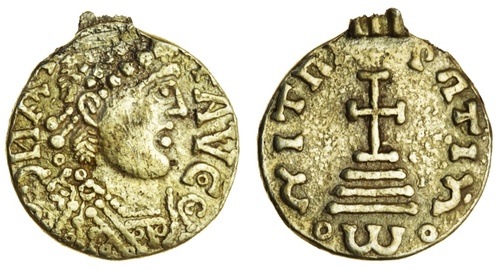
Auction: 20004 - British Coins and Commemorative Medals: Spring Auction - conducted behind CLOSED DOORS
Lot: 10
Early Anglo-Saxon England, Pseudo-Imperial issue (c. 640-670), pale gold Shilling pendant, in the style of a 4th Century Solidus, 3.16g, 12h, diademed, draped and cuirassed bust right,
Found Hoo Peninsula, Medway, 8 October 2017
Declared as Treasure and earmarked for acquisition for the National collection. Subsequently disclaimed and returned to finder.
This little-understood series of imitation Solidii carefully executed from Roman prototypes and often found with integral suspension loops first came to the attention of the academic community following Sutherland's analysis of the Crondall Hoard in 1948. Subsequently, Philip Grierson penned an article: 'A New Anglo-Saxon Solidus', Numismatic Chronicle [1953], Vol. XIII, pp. 88-91, documenting a fifth example to add to Sutherland's previous series (1948, nos. 20-22, 76). At time of his writing, the new type was known from three examples exhibiting two obverse and two reverse dies. The first and second examples were double die-linked and resided at the National Museum of Nuremberg since at least 1909, and at the Bibliotheque Nationale since at least 1945. Whilst Gustav von Bezold considered the Nuremberg coin (no. 1) to be the product of Lombardic production in the seventh century, Le Gentilhomme ascribed the French coin (no. 2) to Anglo-Saxon production, to which Grierson added his own approval. He contested that the third specimen, once belonging to Emmanuel College, Cambridge (no. 3) was conceivably a local discovery that had since been lost. Fortunately, casts of that specimen were made for the Fitzwilliam Museum prior to its disappearance, enabling die study to confirm its obverse link to the present coin, although neither its weight nor metal content are at present known.
A discovery in December 1984 at Bell Farm, Minster on the Isle of Sheppy would further affirm Grierson's hypothesis, with the dies of that fourth coin (EMC 1068.0001) also matched with the Emmanuel College coin, and double die-linked to the present example. Current available evidence would suggest that the present offering was originally the product of native manufacture.
The known corpus:
1. Nuremberg, Germanisches National-Museum (Muenzsammlung no. 12372), 3.65g, 12h, c. 75% AV ['base gold'], a fragment of mount adhering to the reverse.
2. Bibliotheque Nationale. 3.96g, 12h, ['base gold'] a fragment of mount
3. Emmanuel College, Cambridge, weight unknown, 3h[?], since lost, known only from a cast at the Fitzwilliam Museum.
4. Lyon Collection. [SCBI 68, no. 1//EMC 1068.0001]. 4.67g, 12h, 56% AV [coin]/68% AV [loop]. Purchased Spink, 1985. Found at Bell Farm, Isle of Sheppy, December 1984.
5. [PAS KENT-5E6A92//BM 2017T929], this coin.
Subject to 20% VAT on Buyer’s Premium. For more information please view Terms and Conditions for Buyers.
Sold for
£10,000
Starting price
£10000




